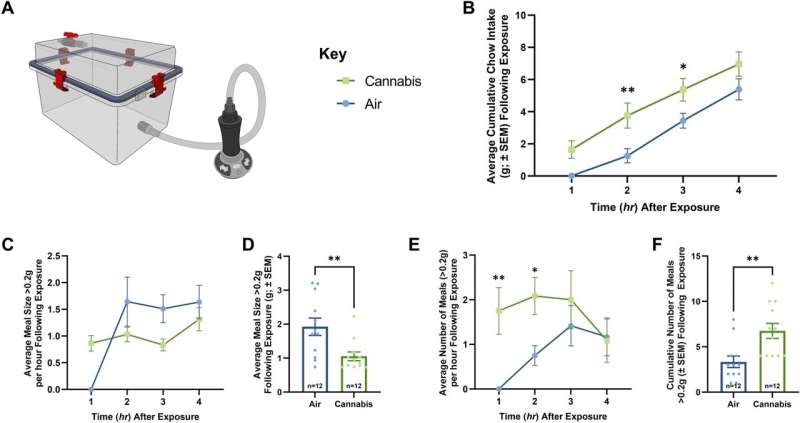Learn about brain health and nootropics to boost brain function
Cannabis found to activate specific hunger neurons in brain

Vapor Cannabis Exposure Augments Meal Frequency. (A) Illustrates the vapor chamber apparatus used in the following studies. (B), (C), and (E) Represent quantification of ingested chow at 1-h intervals following air or cannabis exposure (n = 12/group), significance calculated with two-way repeated measures ANOVA with Tukey HSD post-hoc testing. (D) and (F) Represent quantification average and cumulative meal patterns (n = 12/group), significance calculated with one-way ANOVA test. (B) shows free-feeding rats exposed to 800 mg of cannabis consumed significantly more chow than air rats over 4 h. (C) Displays the average meal size per hour following cannabis and air exposure, statistical testing revealed a significance in the within subjects’ comparison. Meal pattern analysis revealed that vapor cannabis exposed rats consumed smaller meals relative to air-exposed controls (D), and that vapor cannabis exposure led to a trend toward increased total number of meals relative to air-exposed rats by hour (E), means comparison revealed significant differences at the 1 and 2 h timepoints and in total (F). See Supplemental Tables S1 and S2 for ANOVA testing results and post-hoc analysis results respectively. Credit: Scientific Reports (2023). DOI: 10.1038/s41598-023-50112-5 While it is well known that cannabis can cause the munchies, researchers have now revealed a mechanism in the brain that promotes appetite in a set of animal studies at Washington State University.
The discovery, detailed in the journal Scientific Reports , could pave the way for refined therapeutics to treat appetite disorders faced by cancer patients as well as anorexia and potentially obesity.
After exposing mice to vaporized cannabis sativa , researchers used calcium imaging technology, which is similar to a brain MRI, to determine how their brain cells responded. They observed that cannabis activated a set of cells in the hypothalamus when the rodents anticipated and consumed palatable food that were not activated in unexposed mice.
“When the mice are given cannabis, neurons come on that typically are not active,” said Jon Davis, an assistant professor of neuroscience at WSU and corresponding author on the paper. “There is something important happening in the hypothalamus after vapor cannabis.”
Calcium imaging has been used to study the brain’s reactions to food by other researchers, but this is the first known study to use it to understand those features following cannabis exposure.
As part of this research, the researchers also determined that the cannabinoid-1 receptor, a known cannabis target, controlled the activity of a well-known set of “feeding” cells in the hypothalamus, called Agouti Related Protein neurons. With this information, they used a “chemogenetic” technique, which acts like a molecular light switch, to home in on these neurons when animals were exposed to cannabis. When these neurons were turned off, cannabis no longer promoted appetite.
“We now know one of the ways that the brain responds to recreational-type cannabis to promote appetite,” said Davis.
This work builds on previous research on cannabis and appetite from Davis’ lab, which was among the first to use whole vaporized cannabis plant matter in animal studies instead of injected THC—in an effort to mimic better how cannabis is used by humans. In the previous work, the researchers identified genetic changes in the hypothalamus in response to cannabis, so in this study, Davis and his colleagues focused on that area.
Provided by Washington State University
Read more at medicalxpress.com